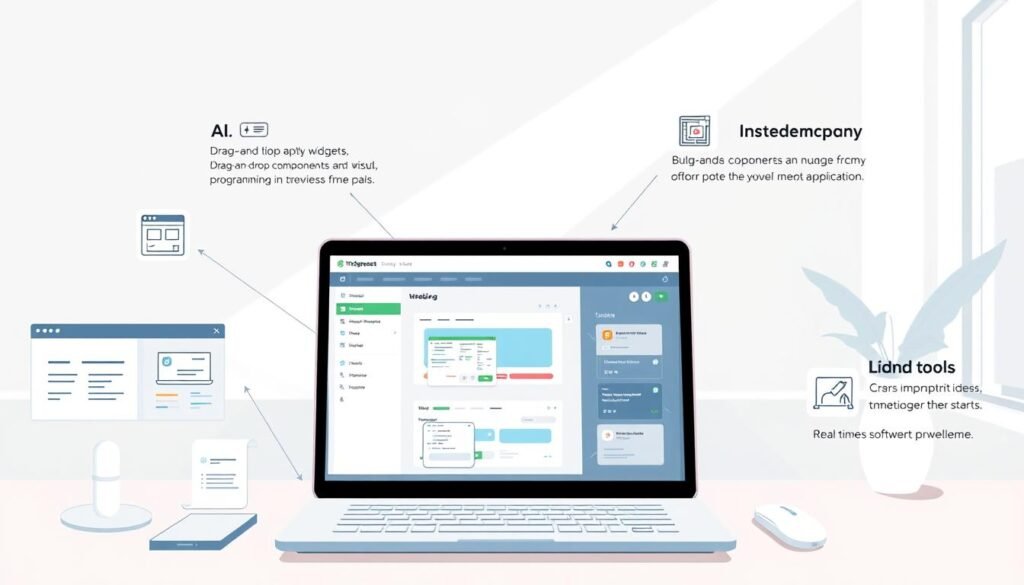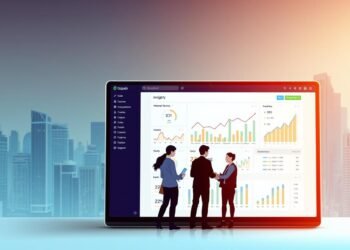In today’s fast-paced digital world, the demand for innovative solutions is skyrocketing. But what if you could create powerful applications without needing technical expertise? Enter visual programming tools that are revolutionizing the way we build apps.
Imagine a platform that simplifies complex development processes, allowing anyone to turn their ideas into reality. This is where no-code platforms shine. They empower users to design, develop, and deploy applications with ease, eliminating the need for coding knowledge.
These tools are not just a trend; they are reshaping the tech industry. By providing a protected environment, they enable users to focus on creativity rather than technical hurdles. This approach makes app development accessible to a broader audience, fostering innovation and collaboration.
As the digital landscape evolves, no-code platforms are becoming essential for businesses and individuals alike. They offer a seamless experience, allowing users to harness the power of technology without the complexity. The future of app development is here, and it’s more inclusive than ever.
Key Takeaways
- No-code platforms simplify app development for non-technical users.
- Visual programming tools are reshaping the tech industry.
- These platforms foster creativity and innovation.
- No-code solutions make app development accessible to everyone.
- They provide a seamless experience without technical complexity.
What is Bubble?
From physical spheres to insulated environments, the concept of a bubble has evolved over time. This term carries a dual meaning, reflecting both literal and metaphorical interpretations. In its simplest sense, a bubble is a delicate sphere of liquid enclosing air or gas. Metaphorically, it represents isolated spaces or ideas, often shielded from external influences.
The Bubble platform, named after this versatile term, embodies its metaphorical essence. It provides a protected environment for users to build applications without coding. With features like workflow automation and database management, Bubble empowers creators to innovate freely. This approach mirrors the fragility and potential for growth inherent in the term itself.
Definition and Overview
Historically, the word “bubble” first appeared in 14th-century Middle English. Over time, its meaning expanded beyond physical phenomena. For instance, the 1637 Tulip Mania marked the first recorded economic bubble, where prices soared and collapsed rapidly. Today, the term is used in various contexts, from financial markets to technology.
Historical Context of the Term “Bubble”
In financial contexts, bubbles often signify delusive schemes or unsustainable growth. However, in the tech world, they represent innovation and opportunity. The Bubble platform exemplifies this positive interpretation, enabling users to turn ideas into reality. Its namesake reflects both the fragility of new ventures and their potential for success.
Bubble as a No-Code Platform
The rise of no-code platforms has opened doors for creators of all skill levels. These tools are designed to simplify app development, making it accessible to everyone. Whether you’re a non-technical founder or part of an enterprise team, no-code solutions like Bubble empower you to bring ideas to life.
How Bubble Empowers Creators
Bubble is a game-changer for people who want to build apps without coding. Its intuitive interface allows users to design, develop, and deploy applications with ease. Over 3 million users have already leveraged Bubble to create marketplaces, SaaS products, and community platforms.
The platform’s responsive design engine ensures your app looks great on any device. With built-in API connectors, you can integrate external services seamlessly. Bubble’s cloud infrastructure handles the heavy lifting, so you can focus on creativity.
Key Features of Bubble
Bubble offers a range of features that make it a standout choice. Its granular permission settings and SOC 2 compliance ensure your data is secure. This is especially important for enterprise teams handling sensitive information.
User demographics show that 42% of Bubble users are non-technical founders, 33% are enterprise teams, and 25% are professional developers. This diversity highlights its versatility. Additionally, Bubble’s pricing models can save users 70-80% compared to traditional development costs.
Economic Bubbles Explained
Economic bubbles have shaped financial history, leaving lasting impacts on markets and societies. These cycles of rapid growth and sudden collapse often stem from speculative behavior and psychological factors. Understanding their causes and consequences is essential for navigating financial risks.
What Causes Economic Bubbles?
Hyman Minsky’s Financial Instability Hypothesis provides a framework for understanding economic bubbles. According to Minsky, financial markets are inherently unstable and follow a five-stage pattern: displacement, boom, euphoria, profit-taking, and panic. During the boom phase, rising asset prices attract more investors, leading to euphoria and unsustainable valuations.
Psychological factors like FOMO (Fear of Missing Out) play a significant role. Investors often rush into rising markets, driven by the fear of missing potential gains. This collective behavior fuels speculative investments, pushing asset prices to unsustainable levels.
Examples of Historical Bubbles
The 2000 Dot-com Crash is a classic example of a market bubble. The NASDAQ Composite Index rose over 400% from 1995 to 2000, driven by investor enthusiasm for internet-based companies. However, many of these companies were overvalued and lacked sustainable business models. When the bubble burst, the market lost approximately $5 trillion in value.
Another notable example is the 2008 Housing Crisis. Easy credit and speculative investments in real estate led to a rapid rise in housing prices. When the bubble burst, it resulted in over 10 million foreclosures and a global financial crisis. These examples highlight the cyclical nature of financial markets and the devastating impact of bubble bursts.
By studying these historical events, we can better understand the warning signs of economic bubbles and take steps to mitigate their risks.
Bubble in the Stock Market
The stock market is a dynamic environment where rapid growth and sudden collapses can redefine fortunes. These cycles, often referred to as bubbles, are driven by speculation, investor psychology, and economic factors. Understanding their mechanics is essential for navigating financial risks effectively.
Understanding Stock Market Bubbles
Stock market bubbles occur when asset prices rise far beyond their intrinsic value. This is often fueled by speculative behavior and investor optimism. For example, during the 2008 financial crisis, the S&P 500 dropped by 50%, wiping out trillions in value.
Short-selling is a common strategy during bubble collapses. Investors bet on declining prices, profiting from the market’s downturn. Institutional players, such as hedge funds managing $4.3 trillion in assets, often play a significant role in these scenarios.
The Impact of Bubble Bursts
When a bubble bursts, the consequences can be severe. The 1987 Black Monday saw a 22.6% single-day drop, while the 2020 COVID crash led to a 34% decline. These events highlight the volatility of financial markets.
Post-2008, the SEC introduced regulations like the Volcker Rule and stress testing requirements to mitigate risks. Recovery timelines vary, but on average, markets take 3.8 years to fully rebound after a crash.
Understanding these patterns can help investors make informed decisions and protect their portfolios from significant losses.
Bubble in Gaming
The world of gaming offers endless entertainment and challenges for players of all ages. Among the thousands of games available, bubble-themed ones stand out for their simplicity and addictive gameplay. These games have become a staple in the gaming industry, appealing to a wide audience.
Classic Bubble Shooter Game
The classic Bubble Shooter game is a prime example of this genre. With a 4.5/5 rating and over 2.16 million active users, it’s a favorite among casual gamers. The game’s mechanics rely on color-matching algorithms and difficulty progression curves, keeping players engaged across multiple levels.
Player demographics reveal that 68% of users are female, and 45% are aged 35-54. This broad appeal highlights the game’s accessibility and universal charm. Additionally, in-app purchases ranging from $0.99 to $4.99 contribute to an annual revenue of $18 million.
Why Bubble Games Remain Popular
Bubble games continue to thrive due to their therapeutic benefits. Studies show that 62% of players report stress reduction during gaming sessions. The simplicity of gameplay, combined with the challenge of advancing through levels, creates a perfect balance of relaxation and engagement.
Mobile versions, particularly on iOS platforms, enjoy 40% higher retention rates compared to web versions. This trend underscores the importance of accessibility in the internet-driven gaming landscape. Whether on a smartphone or computer, bubble games remain a timeless choice for players worldwide.
Social and Cultural Bubbles
Social interactions have increasingly become confined to specific circles, shaping how we connect and communicate. These social bubbles influence our perspectives, often limiting exposure to diverse ideas. In many areas, people tend to interact primarily with those who share similar beliefs and values.
The Concept of Social Bubbles
Social bubbles are groups where people share common interests or ideologies. According to Pew Research, 64% of Americans are part of politically homogeneous social circles. This phenomenon is not limited to politics; it extends to cultural, professional, and even familial areas.
During the COVID-19 pandemic, 58% of families maintained strict quarantine pods, further reinforcing these bubbles. Such isolation can lead to echo chambers, where differing opinions are rarely encountered. Understanding this concept is crucial for fostering more inclusive communities.
How Bubbles Shape Online Communities
Online platforms play a significant role in creating and maintaining social bubbles. Facebook’s EdgeRank and Twitter’s algorithmic timeline are designed to show content that aligns with users’ preferences. While this can enhance user experience, it also limits exposure to diverse viewpoints.
Reddit’s subcommunities and TikTok’s For You Page recommendations further segment users into niche areas. A MIT study found a 73% increase in ideological segregation since 2010, highlighting the impact of these platforms. However, tools like the Escape Your Browser extension, used by over 850,000 people, offer ways to break free from these bubbles.
By recognizing the role of social and cultural bubbles, we can take steps to broaden our perspectives and foster healthier online interactions.
Conclusion
The concept of bubbles spans multiple disciplines, from finance to technology. In financial markets, bubbles highlight the risks of speculative behavior. In app development, platforms like Bubble empower creators to innovate without coding. Gartner predicts that by 2026, 65% of app development will occur on no-code platforms.
However, bubble mentalities can be dangerous. In investing, they lead to market crashes. On social media, they create echo chambers. A balanced approach is key. Leverage tools like Bubble while staying aware of market trends and diverse perspectives.
Start small with Bubble’s free tier to gain hands-on experience. At the same time, study economic history to understand bubble dynamics. This dual focus will help you navigate both the digital and financial landscapes effectively.
As we reach the end of this exploration, remember that bubbles are both opportunities and warnings. Use them wisely to shape your future.
FAQ
What is Bubble?
Bubble is a no-code platform that allows users to build web applications without needing to write code. It empowers creators to design, develop, and launch apps using a visual interface.
How does Bubble empower creators?
Bubble provides tools like drag-and-drop editors, customizable workflows, and integrations with third-party services. These features enable users to bring their ideas to life quickly and efficiently.
What are the key features of Bubble?
Bubble offers responsive design, database management, user authentication, and API integrations. These features make it a comprehensive solution for building complex applications.
What causes economic bubbles?
Economic bubbles often form due to excessive speculation, overvaluation of assets, and herd behavior. When prices rise rapidly, they can exceed the intrinsic value of the asset.
Can you give examples of historical bubbles?
Notable examples include the Dot-com Bubble of the late 1990s and the Housing Bubble of the mid-2000s. Both saw rapid price increases followed by significant crashes.
What is a stock market bubble?
Why are bubble games like Bubble Shooter so popular?
Bubble games are simple, engaging, and offer a sense of achievement. Their easy-to-learn mechanics and colorful designs appeal to players of all ages.
What are social bubbles?
Social bubbles refer to the tendency of people to interact primarily with others who share similar views or backgrounds. This can limit exposure to diverse perspectives.
How do bubbles shape online communities?
Bubbles in online communities can create echo chambers, where users reinforce each other’s beliefs. This can lead to polarization and a lack of open dialogue.










